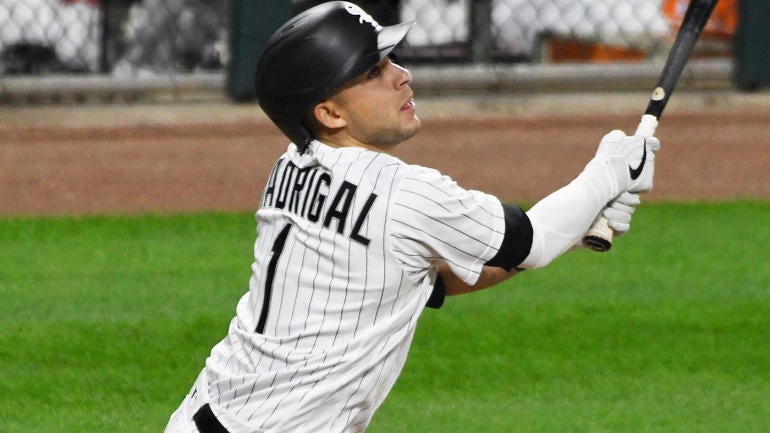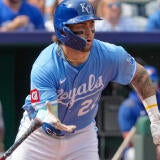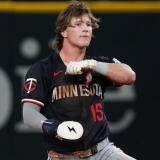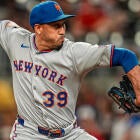Fantasy Baseball Mailbag: Diagnosing your team's problems, how to handle slow starts and more
Our teams have lots of issues at this point, so let's talk about it

We spend an awful lot of time fretting about players when we talk about Fantasy Baseball. Players who are underperforming. Players who are over performing. Players who just need to fix one thing to get back on track. Players who are just about to get their chance to shine. And, every morning, players to consider adding on waivers.
Players are the lifeblood of Fantasy sports, and we wouldn't be here without them. But when it comes to winning a Fantasy league, they aren't everything. We can analyze players as much as we want, coming up with explanations for why they are doing what they are doing and what that might mean for the future, but the truth is, we don't know what they'll do. In a world where you knew what every player was going to do, that's all you would need to know.
In the real world, however, it's not just about players. It's also about your team. And how those players fit into your team. And the decisions you have to make about those players based on imperfect information. This column is about all of that. I'm talking about players, sure, but the goal is to try to provide some more generalized help as you go about building, tweaking, and occasionally rebuilding your team this season. I went to Twitter to crowdsource some ideas for more team-centric questions, and here's what you all gave me.
Let's fix those teams, or at least try:
a problem i always seem to get is one position group being dreadful, so I spend a bunch of time trying to churn a chunk of my roster trying to solve one or two spots, and i sometimes wonder if its worth it to raise the floor of the worse spots or raise the ceiling of others.
— x is a y z (@bviimarlins) May 19, 2021
In recent years, positional scarcity has become much less of a concern in Fantasy, and while that's not to say that every position is made equal, it is to say your focus should be on finding the best players -- period. Constantly churning through second basemen isn't a bad idea, but doing so at the cost of targeting better players at other positions just isn't worth it. You're going to have weak spots somewhere, so there's value in embracing it. You're not winning or losing based on how many positions contribute a minimum amount of production, you're just trying to outscore your opponents. Passing up a better player on waivers -- or dropping someone you really like -- because you feel like you need to find an answer at one spot may not necessarily be the right decision. Especially because the quality of player you're likely to find on waivers at a weak position probably aren't going to be worth the squeeze anyway. Your best option may be to try to trade from a strength.
I've actually struggled with this so far this season myself, so I know how hard it can be. In many of my leagues, outfield has been a problem for me, and in one particular, I've churned through a ton of outfielders trying to find the right answer. It hasn't cost me too much, but I did drop Joc Pederson back toward the end of April when he went on the IL. Now he's hitting .400/.440/.489 in the month of May and I'd sure like to have that bat around. But the bigger mistake I made was when I dropped Tony Gonsolin for Matt Beaty. Gonsolin is nearing his return to the rotation and has top-30 potential at SP. That's two I wish I could have back.
Maybe balancing or fixing lopsided teams (like you're pitching is dope but hitting stinks that sort of thing?)
— Daniel (@DanielJPort) May 19, 2021
In that aforementioned league, I have one of the most unbalanced teams I've ever assembled so far. I'm the second-best team in pitching with 52 standing points, ranking no worse than 10th in any category. And I'm second-to-last in hitting category points with 18.5 -- and that's while ranking first in batting average. I'm last in HR and RBI and second-to-last in R and SB. And I only spent 33.8% of my budget on pitching!
What do you do to fix it? Well, first you've gotta figure out whether your struggles are real. In that league, I've been missing Ketel Marte for much of the season and I've had an underperforming Anthony Rendon and Corey Seager dragging me down. Things should be better moving forward with Marte healthy and with Rendon likely to play better than he has so far, but Seager's absence presents another challenge. I can hope for better play from Andrew Vaughn and Victor Robles, and I'm still stashing Brendan Rodgers and Wander Franco who should help, but it still may not be enough.
Which means I've probably got to start looking to trade from a position of strength to fill holes. If you find yourself in a similar situation, where even expected improvement from your struggling players might not be enough to fix it. For me, that means dealing from my pitching. Even with Jesus Luzardo and Zac Gallen on IL and Luis Severino still stashed, I could probably afford to move a pitcher. I know my league-mates read my stuff so I don't want to give away too much, but Freddy Peralta, Trevor Rogers, and Aaron Civale may suddenly become available via trade. Hit me up.
Is something like No power or speed when expected not broad enough? Or no Ks for pitching (but not many examples there)
— Brian Curski (mostly Pictures, Baseball, Music) (@CurskiPics) May 19, 2021
This is certainly one of the risks of targeting players in Roto who are "specialists." They say speed doesn't slump, but Victor Robles' four steals and Nick Madrigal's one suggest otherwise. I targeted both players in Roto leagues for the hope they could provide a boost there, and they just haven't done it. When you're dealing with situations like that, once again the first step is to determine how real their struggles are. Steals especially are unpredictable on a game-by-game or even week-by-week basis, but homers can also come in bunches. And saves and batting average are especially volatile as well. If you're "missing" those stats, you need to look at the players you've got and figure out whether you can count on them to turn things around.
For Madrigal and Robles, both still have plenty of speed, so that isn't a concern. The question, then, is why aren't they running despite that? In Robles' case, I think there's important context to consider: Baserunners tend to run less batting eighth than from any other spot in the lineup. Robles has started 11 of his 35 games from the eighth spot and attempted just one stolen base despite a .342 OBP in those games. He attempted three in nine starts from the leadoff spot and three more from the No. 9 spot, which would be 42 attempts over a 162-game pace. Robles is dealing with an ankle injury which could certainly slow him down, but he was batting ninth consistently before the injury, so if that remains the case, the steals should follow.
You'll want to look into the players you've got to see if you can find similar reasons for optimism before looking to the trade market. When you are shopping from a position of need, you need to prepare yourself for the likelihood that you'll have to overpay for what you need, so make sure it's actually a need.
SP Usage issues...seems like only a few years ago when a starter went 5 IP even in a mediocre start...now we see SPs get pulled before (gasp) the third time thru the lineup which kills some SP fantasy value
— Killer Chilaquiles (@SpudsMackenzie6) May 19, 2021
Well, unfortunately, there isn't much we can do to fix this issue, because it's a league-wide one. There are 72 pitchers who qualify for the ERA title right now, compared to 87 at the same point in the 2019 schedule and 94 in 2018. This is just where we are with baseball. The starters who routinely pitch deep into games and do so well are also the best pitchers in baseball, and nearly all of them were drafted early and aren't going to be available for cheap.
However, if you're looking for a way to counter that trend, your best bet is to try to target some of those pitchers who might be able to rack up innings while pitching at a high level who haven't done so yet. The most obvious candidates right now are Luis Castillo, Patrick Corbin, Kyle Hendricks and Dylan Bundy, all of whom should be reliable sources of innings and counting stats -- if they can stop pitching so poorly! I would also throw German Marquez, Eduardo Rodriguez, and Madison Bumgarner as three more who should have better days ahead of them and will bring strong counting stats if and when that happens.
What about a Paddack category? Decently high draft picks not playing bad enough to cut be sucking up a roster spot and costing you the chance to pick someone up
— SPG203 (@spg203) May 19, 2021
This is such a frustrating situation. I'm holding Paddack in the leagues where I have him, but I can't say for sure you should. I can't say for sure it's been the right decision, especially in one league with just two IL spots, where I've had to protect Paddack from my toughest lineup decisions. He's staying on my team, but I have no faith that I can start him. Ultimately, there may come a point where I have to move on from Paddack. He hasn't been a disaster, but he really hasn't given you any reason to think things are going to get better. At this point, he's the next guy on the chopping block in many of my leagues, and if I get hit with another injury -- there's no way that will happen this season, right? -- I might have to call it.
And, what separates a Paddack from a Castillo is I don't even really have the track record to fall back on with Paddack. I think he's talented and I don't want to give up on that talent, but I'm not at all confident he'll figure it out. You can also add the likes of Casey Mize, Drew Smyly, Jameson Taillon, and Frankie Montas to this category along with hitters like Dansby Swanson, Dominic Smith, Dylan Moore, Cavan Biggio, and Victor Robles, too. I'd like to believe all of them will figure it out, but I can't predict it with any degree of certainty at this point. And I can't blame you if you do decide to move on from them.
What to do with that great player on your bench due to roster inflexibility and player value.
— Stephen Lydic (@stephenlydic) May 20, 2021
I've got exactly this issue in multiple leagues. In one, I have Luke Voit (and Andrew Vaughn) on my bench because my first baseman is Vladimir Guerrero, my outfielders are Mookie Betts, Aaron Judge, and Jesse Winker, and my utility is Kris Bryant. I'd love to start Vaughn or Voit, but there's just no room for them. In the other league, I've got Yordan Alvarez in my utility spot and I added both Willie Calhoun and Franmil Reyes from waivers on the same day. Calhoun thankfully added outfield eligibility shortly after and he's locked in there, but I ultimately had to drop Reyes because it just wasn't worth having two U-only players.
Ideally, you would be able to trade from this kind of surplus, but that's harder to do when dealing with utility-only players. However, in that first example, I would love if either Voit or Vaughn would get hot quickly so I could start to shop them. Ultimately, that's the best way to solve one of these issues in the short term. It can be easier to say "find a trade" than to actually do one, but if you truly have a surplus, getting back 95 cents on the dollar isn't the worst outcome if it makes you better somewhere else.
Though, it's worth remembering one of my favorite bits of wisdom when it comes to the topic of this kind of log jams:

You only have too many players until all of a sudden you don't. And the way injuries are piling up this year, I wouldn't be so quick to throw away good depth.
Underclassmen-o-meter: Rest of season confidence of players with less than 2 years service time. Small sample sizes to begin with but even worse given ‘20.
— CletusBoJangle (@CletusBoJangle) May 19, 2021
This is a fascinating topic to think about, and you're right: It's harder to know what to make of young players right now. Alec Bohm is a good example, as he had an .881 OPS in 44 games in 2020 and now has a .596 OPS in 43 games this season. Bohm has taken a step back in just about every way imaginable as a hitter, and while his underlying numbers suggest better days are ahead, they don't exactly scream "star." He's striking out 26.6% of the time and has a .268 expected batting average and .453 expected slugging percentage, which isn't that much different than his .280/.329/.411 mark between both seasons. It sounds a lot like Brian Anderson or Kyle Seager. There's nothing wrong with those players, but we weren't drafting them around the top 100.
Someone like Trevor Rogers has followed the opposite path. He struggled in seven starts in 2020, putting up a 6.11 ERA, though with tons of strikeouts and much more palatable ERA estimators. This season, he's looked like a budding ace, with a 1.74 ERA in nine starts. Overall, he's got a 3.28 ERA and 3.43 xFIP in 79.2 innings -- that's very good for a young pitcher, but is a little bit less enticing when combined with his pitch count limitations. He looks like maybe a sell-high candidate, especially because the Marlins may choose to limit his innings later on, too.
Without going through every single player who qualifies here, I would just say that it's probably a fool's errand to try to slice up the already small samples and try to identify where the "real" version of these players is. We're desperate for information about these players, and you're usually better off taking the larger sample size of a players' career to try to find the truth. That's not to say players haven't changed from 2020 -- young players especially. However, we should still be treating the numbers we're seeing right now with a healthy degree of skepticism, and even more so for young players.

















